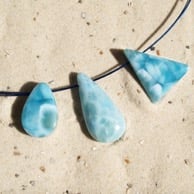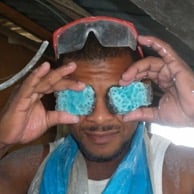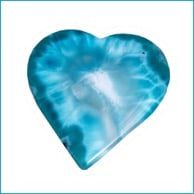Larimar - Gemstone of the Caribbean
The name "Larimar" | The name "Larimar" is composed of the maiden name "Lari" and the Spanish word "Mar" for "sea". The stone has been known by this name since 1975, when Miguel Mendez, owner of a Larimar mine/expert in handicrafts in the Dominican Republic, invented it, making the name of his daughter Larissa known worldwide. Before this time, Larimar was also called Travelina, but Larimar is much better known under its esoteric name Atlantis stone, because according to legend, a part of Atlantis was located in the territory of today's Dominican Republic. Jewelers, goldsmiths and jewelry designers also like to call the Larimar "Gemstone of the Caribbean". Mineralogical databases list the Larimar as a light blue variety of pectolite. |
The creation of Larimar | Larimar is formed magmatically-hydrothermally in veins and fissures of basic, weathered volcanic rocks, so-called basalts. By hot liquids the copper sulfide chalcocite (Cu2S) present in the basalt is dissolved and gives the Larimar its blue color. | Larimar locations | Larimar is found almost exclusively in the Dominican Republic. The mines are located near Baoruco in the province of Barahona in the southwest. The second site "Fittà" near Soave in Italy is much smaller and the stones also do not have the intense bright blue of the Caribbean relatives, so Larimar from Italy is only of interest to collectors, but is not processed into Larimar jewelry. |
Appearance image of Larimar | The mineral Larimar does not form visible crystals, but dense aggregates in elongated cylinders (so-called "tubes") or nodules from a few millimeters to no more than 10cm in diameter. When cutting through the cylinders, the radial structure from the inside to the outside to the gray-brown crust and the fibrous structure is often easy to recognize. Characteristic of the stone from the Caribbean is its white to light blue color; the more blue is found in a stone, the more valuable it is. Color-giving trace element is Copper or Vanadium. Light bands in Larimar can also be Natrolite, gray flecks Calcite. Dark to black inclusions consist of chalcocite (copper luster). Also typical are the wine-red inclusions of Hematite, which sometimes look like a small tree in the Larimar. |
Mineralogical profile | * Ca2Na plus trace elements such as Copper, Iron, Potassium, Manganese, Vanadium and Phosphorus. * Luster: silk or vitreous luster * Cleavage: perfect * Mineral class: chain silicates, pectolite * Mohs hardness: 4.5 - 5 * Density: 2.74 - 2.88 * Stroke color: White * Transparency: translucent to transparent * Crystal system: triclinic |
Distinction from other minerals | Larimar is the blue variety of the mineral pectolite and therefore has some close "relatives". Pectolite is found in over 3000 different places, in Germany, for example, in the Black Forest and Sauerland. However, the stones found there are colorless, white, gray-white, yellowish or pink - no other pectolite has such a unique blue color as the Larimar. |
Confusion and Larimar fakes | Due to its unusual color, radial structure and fibrous texture, there is little possibility of confusion with other minerals. Externally similar can be bright Turquoise, colored Magnesite (Turquenite), blue Calcite and Aragonite, but all of them are much softer than Larimar. Since genuine Larimar is one of the more expensive stones due to its rarity, imitations of light blue Glass or colored Magnesite are occasionally found, but are usually very uniform in color and pattern. | Mythology and lore about Larimar | Only since the mid-1990s Larimar is known to a wider circle of people and has found its way into modern stone medicine. From its place of discovery in the Dominican Republic, no traditions for the use as a healing stone are known. |
effect of Larimar | Larimar is the ideal healing stone when it comes to taking life into one's own hands and overcoming a passive basic attitude, from which one easily feels like a victim, The realization that the limits of the mind are only those in which we believe and which we set ourselves, is strengthened by the Larimar; the stone gives the feeling of (mental) expansiveness and supports (spiritual) growth. Openness becomes possible, but also the demarcation to the outside becomes easier. With its help, negative things can be overcome; it brings calm and serenity, especially in dramatic changes and big emotions. Absorbed impressions can be better processed. Through the blue Larimar can promote goal-oriented thinking and creative action. Circumstances that can not be influenced or changed are more easily accepted, a different perspective helps to more serenity. |
Possibilities to apply Larimar | Larimar is a classic stone for meditation. As a slice or sawn open tuber, its contemplation can convey serenity, it helps to calm down and turn the gaze inward. Also laid as a stone circle, Larimar can be used for meditation. Placed on the forehead, chest or solar plexus, the stone from the Dominican Republic can dissolve energetic blockages and expand the ability to perceive. Gemstone Water with Larimar has a powerful effect; for the preparation of all common methods are suitable. |
Astrological mapping, chakra mapping | Astrology uses Larimar for Pisces-born to boost self-confidence and the ability to set boundaries. Larimar is associated with the throat and forehead chakra. |
Larimar jewelry | Larimar is very difficult to cut due to its mineralogical nature, because of the fibrousness of the material many stones already break in the first processing step. From 1kg of rough stones you usually get only about 100 grams of cabochons, which can then be further processed into Larimar jewelry. Particularly popular is Larimar as silver jewelry, because through this precious metal the color of the gemstone is particularly well accentuated. Whether as Earstud, necklace or ring - the "Gemstone of the Caribbean" Larimar is gladly bought as a gift. | Other uses of Larimar | There are currently no known further applications of Larimar, for example in the technical field or in homeopathy. |





